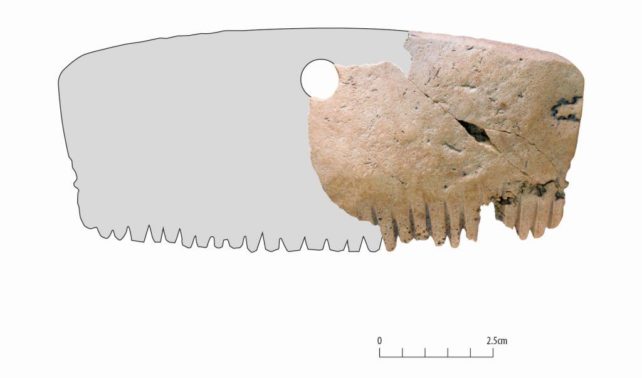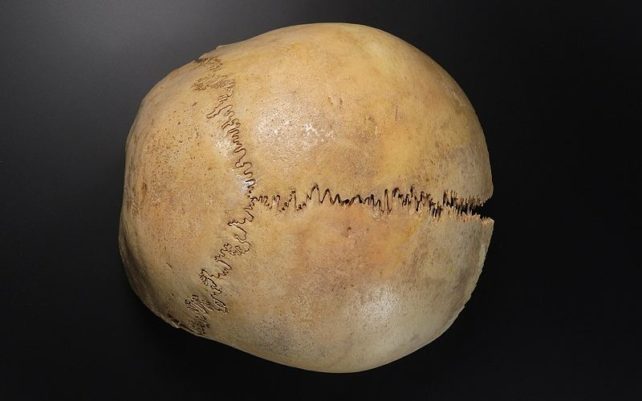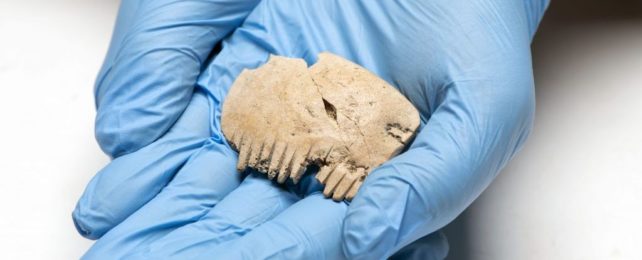A peculiarly gruesome artifact has been uncovered during archaeological digs in England, hearkening back to long lost cultural practices that today we can only try to imagine.
Several years ago, near a village just a few kilometers north-west of Cambridge called Bar Hill, archaeologists from the Museum of London Archaeology (MOLA) dug up a comb dated to around 750 BCE to 43 CE, one made of bone.
But not just any bone. This artifact, scientists discovered, was carved from a human parietal bone, part of the human skull.
Other Iron Age artifacts made of human bone have been found in the Cambridgeshire region before, but this one was particularly unusual. There's no wear pattern on the teeth of the comb, suggesting that its purpose was ornamental or spiritual rather than practical.
The digs were conducted ahead of improvements to a major highway, as per British development planning guidelines. After thousands of years below ground, the comb itself doesn't look particularly important. Just a rectangular piece of bone small enough to fit into the palm of the hand, carved into a comb-shape, now cracked with broken teeth.

It appears to have been part of a larger object at some point; one edge is clearly broken, with part of the rim of a carved circular hole. This led MOLA archaeologist Michael Marshall to a hypothesis: the comb could have been an amulet of some kind, worn as a pendant.
"The Bar Hill Comb may have been a highly symbolic and powerful object for members of the local community," Marshall told the BBC.
"It is possible it was carved from the skull of an important member of Iron Age society whose presence was in some way preserved and commemorated through their bones."
Cambridgeshire has yielded tools made from the arm and leg bones of humans, used for cleaning animal skins, but the skull had special significance. Across Iron Age Europe, pendants made from human skulls are relatively common. In fact, ancient pendants and tools made from human bones have been found around the world.
But the comb carving is really odd.
Only two other Iron Age combs made from human bone have ever been found in Britain, and they hail from the same general region: Earith, 14.5 kilometers (9 miles) north of Bar Hill, and Harston Mill, 19 kilometers to the south of Bar Hill.
This suggests that this specific type of artifact may have been a local cultural custom.
As for what the comb shape signifies, MOLA osteologist Michael Henderson thinks the answer might be in the skull itself. The human skull is not one whole piece, but separate bones that are connected by fibrous tissue known as cranial sutures. These joints resemble the teeth of zippers or, well, combs.

So perhaps, the researchers suggested, the teeth of the Bar Hill Comb were carved to remind people of where the bone came from.
"These carved teeth and lines would have highlighted the Bar Hill Comb's origin, especially for local Iron Age communities who were familiar with skeletal remains," Marshall explains. "Its symbolism and significance would have been obvious to anyone who encountered it."
But then, it's possible that the people who lived around Bar Hill thousands of years ago may have had multiple practices that would appear very peculiar to us today. The dig also turned up a great quantity of frog and toad bones – around 8,000 – in a ditch next to a roundhouse. How and why these bones ended up there is a real head-scratcher.
Let's hope future digs reveal more clues to these fascinating mysteries.
